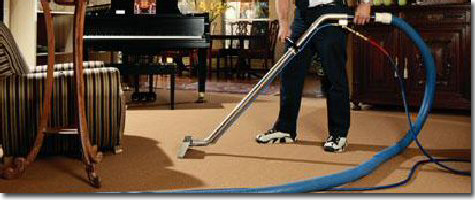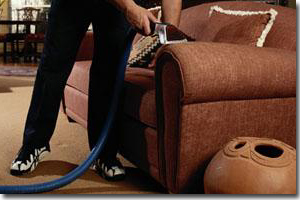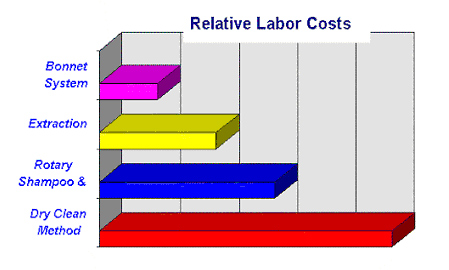

While every home is different, most homes should have the carpet cleaned a minimum of once a year. We usually recommend every 6 months though, this will help keep your carpets in great condition. Especially if you have children, pets or heavy traffic.
Having your carpets cleaned can help eliminate Micro organisms that come from things like dust mites, food particles, soil, pollen and bacteria. Improving the indoor air quality of your home. Adding to the life of your carpets and helping you have a healthier home.
Pre-Visit Tips
There is very little that you need to do to prepare your home for our arrival. The only thing we ask is that you remove any plants, lamps, knick-knacks or other items resting on the carpet or furniture from the rooms being cleaned. Our technicians will handle moving furniture and other items the day they arrive.
Post-Visit Tips
While our truck-mounted vacuum system removes almost all of the moisture immediately, your carpet or upholstery may still be damp to the touch. Using fans in any rooms cleaned and turning your air conditioning or heating system on can help accelerate drying time. Be sure to leave the protective blocks under furniture legs and any paper used with upholstered items in place until the carpet and/or furniture is completely dry to avoid any color transfer.
You may walk on your carpet immediately after cleaning, but avoid wearing street shoes, as they may re-soil your carpet. Be especially careful when walking from damp, carpeted areas on to non-carpeted areas to avoid slipping.
Between Cleanings
The normal hustle and bustle of everyday life can take its toll on your carpet. To keep yours looking its best between professional cleanings, vacuum heavy traffic areas two to three times a week, and the rest of your carpet once a week.
Using indoor and outdoor mats at each entrance can reduce the amount of dirt tracked into your home. Be sure to clean these periodically to ensure their utmost effectiveness.
Useful Tips
- In a pinch, make your own spot remover by mixing 1/4 teaspoon liquid detergent (without bleach) and 1 cup cold water.
- Over time, the stain-resistancy of stain-resistant carpet wears down. For optimum performance, have a protector regularly applied after cleaning.
- Stain-resistant does not mean stain-proof. Be sure to act immediately to prevent spots and spills from causing permanent damage.
- Your furniture collects everyday dirt and soil just like your carpet. For convenience, have both professionally cleaned at the same time.
- Vacuum frequently and thoroughly. Most of the wear of carpeting is caused by dirt. Oily soils attract more oily soil and frequent vacuuming will reduce soil buildup.
- Get at stains quickly, 99% of all stains can be removed by one cleaning agent or another if they are cleaned in the first few days. The longer a stain chemically reacts with the carpet the harder it will be to remove it.
- Test carpet before scrubbing, extracting or spotting. All carpets are different. Some carpets are very sensitive to acid type cleaners and will lose their color quickly. Other carpet dyes are sensitive to harsh alkalis.
- Use appropriate spotters starting with the mildest. Do not use harsh spotting agents unless absolutely necessary and always neutralize high alkaline or high acid cleaners after use.
- Never dig or brush spots. The proper procedure is to scrape the spot towards the middle and then tamp the spot into the white towel or cloth using a brush or other tamping devices. A meat tenderizer makes a great tamping tool.
- Do not overuse detergents, shampoos or spotters. Too much detergent will result in residual left in the carpet that even thorough vacuuming may not remove.
- Do not overwet carpet. Our carpet detergents are chemically active enough so they do not need a tremendous amount of wetting. Over-wetting can cause brownout, carpet shrinkage, adhesion problems and all other kinds of nightmares.
- Extract residual if possible. Rotary scrubbing will clean the carpet fibers the best by encapsulating dirt and detergent residue, which powders off the carpet. Periodic extraction will flush out this dirt and other organisms deep in the carpet.
- Never "coat" a dirty or spotty carpet. After scrubbing or extracting a dirty carpet, if you are not satisfied with the results, do not apply a coat of carpet protector as this will result in "gluing in the dirt" making it harder to remove it the next time. Either re-scrub or extract the carpet or leave the carpet until the next cleaning cycle before you coat.
- Vacuum frequently and thoroughly. It is so important it deserves two recommendations.
How do you get candle wax out of carpet?
We speak from personal experience when we tell you this quick and easy solution works wonders:
- Let the wax harden, then scrap off the excess with a dull knife, fork or spoon.
- Place part of a paper bag, a sheet of newspaper, paper towels, or a clean cloth over the wax.
- Using a warm iron, press gently on the paper bag. Be careful not to leave the iron in one place too long or you may burn the carpet fibers.
- Voila! The paper bag will soak up the melted wax.
- Use a new paper bag as often as necessary until you get all of the wax. This can take some time. Put an ice cube or two on the wax to freeze it, leaving them there for a minute. This should harden the wax enough to break it up and get more of it out.
- To remove stains left from colored wax, try gently dabbing the stain with a rag dampened with rubbing alcohol. Be sure to use the clear alcohol, not the colored ones. If the alcohol doesn't do the trick, Heloise, that domestic goddess, recommends using dry cleaning solvent.
- When done, whichever method you used to get the candle wax out of the carpet, rinse the area with clean water. Blot up the excess water, and dry the area quickly. A fan can help with this. Quick drying prevents any of the dye stains deeper down from wicking up of the surface.
The Difference Between Steam and Dry Cleaning
When calling on a professional carpet cleaning service, you should ask them what method of cleaning they use... because you can bet there are many. Basically there are two primary cleaning methods frequently used today: Hot Water Extraction (Steam Cleaning) and Dry Cleaning.
Dry cleaning involves a foam or powder-like mixture. This mixture is applied and bonnet machines are used to smear the mixture deep into your carpet. After these chemicals are aggitated and allowed to dry, a vacuum is used to remove both the "dry mixture" and the dirt in your carpet.
Unfortunately, there is usually a terrible residue left behind because Dry Cleaners do not rinse and remove the products they apply to your carpet. This residue WILL attract future dirt and cause your carpet wear and become dirtier faster. Ultimately, you'll need to have your carpet cleaned more frequently!
Hot water extraction, on the other hand, is sometimes compared to washing your hair. First the Carpet Cleaning Technician should vacuum the entire area that needs cleaning with an industrial strength vacuum. Then a gentle, pH balanced product is applied to your carpet that further breaks down any remaining dirt. A carpet rake is used to aggitate this product into the carpet; similar to applying shampoo to your hair and aggitating it in with your fingers. Steam is then introduced to thoroughly rinse your carpet and remove all Dirt, Dander, and Cleaning product out to a holding tank located in the cleaning vehicle outside. Logically, hot water extraction makes more sense as opposed to smearing your DRY hair with shampoo and going about your day!
Hot water extraction is likely the method required by your carpet manufacturer to preserve your carpet's warranty. Research indicates hot water extraction cleaning is best for all types of carpets. It leaves the least amount of residue and therefore will provide the lowest amount of re-soiling.


FACTS: Pet Stains
Owners of even the best-trained pets will occasionally encounter pet accidents. Often, the urine is not discovered until long after the accident. The types of damage from pet stains can be diverse and are dependent upon the makeup of the urine. Urine content will change over the petís life because of the petís diet, medications, age, health, sex, and reproductive cycles. Because of these variations, some urine stains may not be removable.
To treat urine-damaged areas:
- Blot damp areas as soon as the urine is detected, with plain white paper toweling.
- Apply a solution of 1/4 teaspoon of a liquid dishwashing detergent (non-bleach and non-lanolin) with one cup of lukewarm water. Do not use automatic dishwashing detergent or laundry detergent.
- Absorb the moisture with paper towel, rinse with warm water and repeat the application of detergent. Continue rinsing and blotting with the detergent solution and water as long as there is a transfer to the toweling or improvement in the spot.
- Follow the detergent application with a solution of one cup white vinegar to two cups water, and blot dry.
- Apply a half-inch layer of paper towels to the affected area, and weigh down with a flat, heavy, non-fading object. Continue to change paper towels until completely dry.
Urine can affect the dyes used in carpet, although not all occurrences will result in a permanent stain. Success is dependent upon the content of the urine, the dyes and finish used, and the time elapsed after the deposit. Some urine spots may be immediately noticeable, while others may take weeks or months for a reaction. The dyes may change color immediately after contact with urine.
When urine spots develop slowly and are noticed after much time has elapsed, the dyes and carpet fibers may be permanently damaged. In beige carpet, blue dyes are attacked by pet urine, leaving behind the red and yellow dyes with a resulting stain appearing red, yellow, or orange. Pet urine, left unattended, can damage carpet in several ways. Moisture can weaken the layers of the carpet, allowing separation or delamination of the backing material. Seam areas can be particularly damaged and can separate.
Another problem, especially with cats, is odor. Unless the cat urine can be completely removed, complete odor removal is unlikely. A number of products are available to combat odor, but may simply mask the odor, and, in times of high humidity, the odor may reappear. Recently, enzymes, available at pet stores and veterinary offices, have been developed that are more effective; but they may be better used by a carpet cleaning professional. If odor cannot be removed, the damaged area of the carpet can be replaced with a piece from reserved scrap. If carpet replacement is necessary, then replacement of cushion and even subflooring may also be necessary.
Some carpet manufacturers have developed backings that resist spills and even prevent the spillage from penetrating the carpet into the carpet cushion and, perhaps, the subfloor. Check with your carpet dealer about these products.
Please call us at (310) 374-5885 or fill out our online form for a free quote.

